You probably already know the basic open position for C major. But what other options can you use for playing a C major chord on baritone ukulele, and why would you want more than one way to play a chord?
For me the number one reason to use different positions for the same chord is to make faster chord changes. (I explain all my tricks for faster chord changes in this article.)
Number two is controlling the high note to form a melody, called chord melody or chord soloing.
Number three for me is controlling the low note, the bass note, which gives chords a slightlly different flavor and lets you make interesting bass lines with the low notes.
In this article we cover five different ways to play a C major chord, the names of all the notes you’re playing, tips for when use the option, and what the notes look like in music notation.
At the end, I’ve included an Appendix for Theory Nerds, to show where a C major chord appears in the keys that you’ll typically be using on baritone uke.
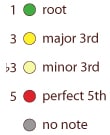
C Major – Option 1
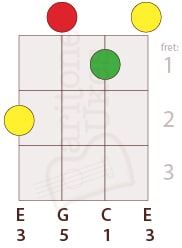
Option 1 is the basic open position for C major on baritone ukulele.
In this position, the notes from lowest to highest are E-G-C-E, like this:
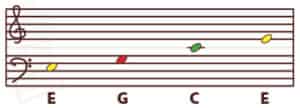
Use the fingering below to switch quickly between a C major chord and an A minor chord, which you will need to do often in the key of C:
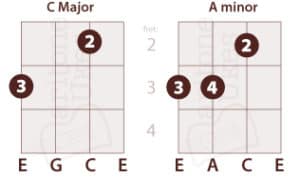
Here’s the moveable version of the C shape. Use it on the 12th fret to play a C major chord.
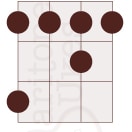
C Major – Option 2

Option 2 is the same as option 1, except that you add your pinky to the 3rd fret on the E string. The C major chord can be played with or without the pinky on the third fret. Both are equally correct.
Option 2 is very handy when switching back and forth between C and G in a song, a common chord change in both of the two most popular keys, C and G. You’ll only have to move your pinky up and down to change chords.
The notes you’re playing with option 2, lowest to highest, are E-G-C-G. Here’s how it looks in music notation:

C Major – Option 3
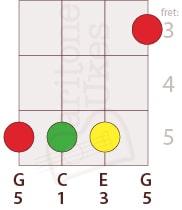
For option 3, go to the 3rd fret and use the moveable A major shape to play a C major chord.
This option is very handy when you need to change between C major and Bb major, which occurs frequently in the key of F major*. You can use the same shape for both chords, positioned on the first fret for Bb, and the third fret for C.
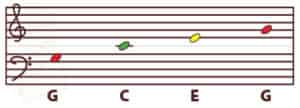
*The IV chord and V chord of F major are Bb major and C major.
C Major – Option 4

Option 4: On the 5th fret, use the moveable G shape to play a C major chord.
Tip: when you fret all the strings on the 5th fret, the notes are CGEA, which you can remember with the phrase “God Created Everything Amen.” These notes are the same as the open strings on a traditionl ukulele (soprano, concert, tenor).
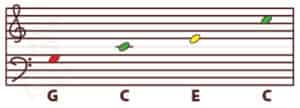
C Major – Option 5
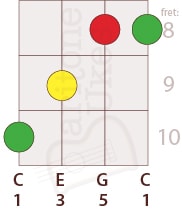
Option 5: On the 8th fret, use the moveable E shape to play a C major chord.
You might recognize this shape the F shape at first. But when played in the open position, on the “zero” fret, you’ll see that at the most basic level, the F shape is actually a barre E shape.
This is the first position on the neck where you can get a C note on the bottom of a C chord. It is also the shape for playing a root poisiton C major chord, i.e. C-E-G-C, i.e. 1-3-5-8.

Tip: Whenever you use the E shape (and F shape), you are playing a root position chord, i.e. 1-3-5-8.
For more options for playing C major chords and other chords, check out my article about the CAGED method for playing chords across the neck on baritone ukulele. I spent weeks on those illustrations. Hope you find them helpful!
Appendix for Theory Nerds
This chart shows you where a C major triad occurs, in terms of scale degree, in the six easiest keys for baritone ukulele.
I recommend focusing on the easiest keys for baritone uke, and using a capo if you absolutely must play in other keys.
Some ukulele and guitar teachers recommend focusing on just two keys, C major and G major. I think that’s a great idea, for starters. But for baritone ukulele, I also recommend working with the key of D, because D is the lowest note on your bari uke.
But, at the most, I would stick to the six easiest keys for baritone ukulele.
Getting back to our C major triad chord and the 5 options shown above, any particular major chord functions as a different scale degree in different keys. Like this:



0 Comments